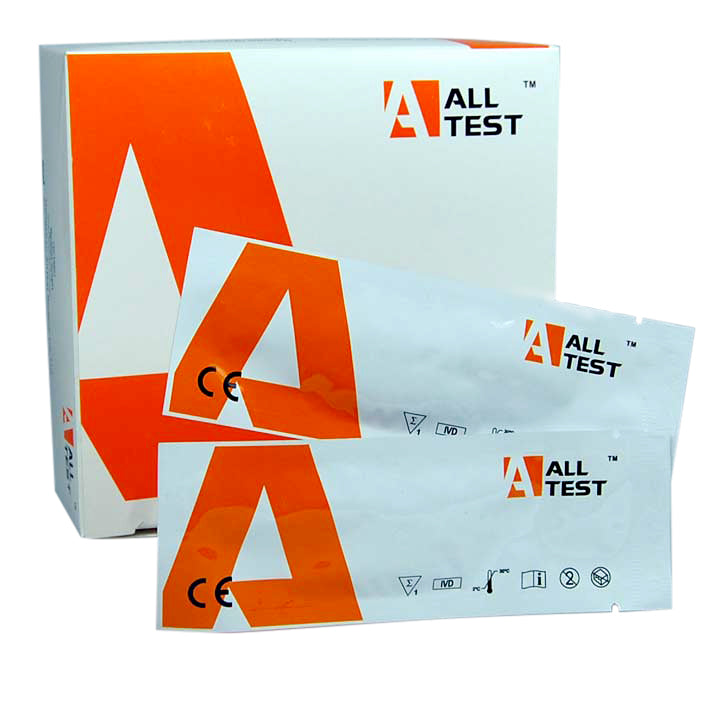Author : John Garside
One of the most common questions people ask when preparing for a drug screening is: how long does it take to get below 50 ng/ml in a urine test? This threshold is the standard cutoff for detecting Cannabis (THC), but similar principles apply to other substances. The answer depends on the specific drug, how often it is used, and individual factors like metabolism, body fat, and hydration.
This guide explains what the 50 ng/ml level means, how long it usually takes for drugs like cannabis, cocaine, and ketamine to drop below detection in urine and saliva tests, and what differences exist between the two types of drug testing.

ALLTEST Cannabis Drug Testing Kits
50ng/mL
Our best value cannabis drug testing strips THC50
What does 50 ng/ml mean on a drug test?
When labs test for drugs, they measure concentration in nanograms per milliliter (ng/ml). Each drug has a set cutoff level. If the concentration in the urine sample is above the cutoff, the test shows positive.
- For cannabis (THC), the standard urine cutoff is 50 ng/ml.
- Other drugs may have different thresholds depending on the testing protocol.
Falling “below 50 ng/ml” means the individuals body has metabolised and eliminated enough of the drug or its byproducts to pass a standard 50ng/ml drug test.
How long drugs stay detectable in urine
Urine tests are the most common method for workplace and pre-employment drug screenings. They usually show a longer detection window compared to saliva tests, especially for cannabis.
Cannabis (THC) in urine
- Single use: 1–3 days
- Occasional use (once a week): 3–7 days
- Regular use (several times per week): 7–21 days
- Heavy daily use: 30 days or longer
Why it lingers in urine: THC is stored in body fat and slowly released, which is why frequent users of cannabis can test positive weeks after their last use.
Cocaine in urine
- Single use: 1–2 days
- Regular use: 2–4 days
- Heavy use: Up to 7 days
Key point: Cocaine itself clears quickly, but its metabolite benzoylecgonine remains detectable for longer.
Ketamine in urine
- Single use: 1–3 days
- Frequent use: 3–7 days
Note: Like THC, ketamine is fat-soluble, but its detection period is usually shorter.
How long drugs stay detectable in saliva
Saliva (oral fluid) testing is often used in roadside or quick-result drug screenings. Compared to urine, detection windows are much shorter.
Cannabis (THC) in Saliva
- Single use: Up to 16 hours
Cocaine in Saliva
- Single use: 24–48 hours
- Frequent use: 2–3 days
Ketamine in Saliva
- Single use: 1–2 days
- Frequent use: 2–4 days
Urine vs saliva drug testing-which is best?
Both types of drug tests measure the presence of drugs, but they behave differently:
- Urine drug tests: Detect longer-term use. More reliable for identifying patterns of drug consumption.
- Saliva drug tests: Better for detecting very recent use. Less invasive and harder to tamper with, but with shorter detection windows.
- Cutoffs: Urine cutoffs are standardised at 50 ng/ml for cannabis, while saliva tests can use lower thresholds, meaning they may detect recent use even if urine does not.
How cutoff levels affect detection: 10 ng/ml vs 50 ng/ml vs 100 ng/ml
Urine drug tests use cutoff levels to determine whether a sample is positive. For THC, common cutoffs are 10 ng/ml, 50 ng/ml, and 100 ng/ml.
- 10 ng/ml (very sensitive ): Can detect even very small amounts of THC. Occasional users may test positive slightly longer than with higher cutoffs.
- 50 ng/ml (standard): Most workplace and lab tests use this. Detects regular users while minimising false positives from incidental exposure.
- 100 ng/ml (less sensitive): Only detects higher THC levels. Light users may test negative sooner, but for frequent or heavy users, the difference is minimal.
Key points to remember with THC detection:
- For heavy or chronic users, the difference between 10 ng/ml, 50 ng/ml, and 100 ng/ml is small — the THC levels stay above all these thresholds for weeks.
- For light or occasional users, a lower cutoff (10 ng/ml) may keep them testing positive slightly longer, while a higher cutoff (100 ng/ml) may allow a faster negative result.
- Overall, the 50 ng/ml cutoff remains the standard reference point for most workplace urine tests to detect Cannabis use.
Factors that affect how long drugs stay in the system
Several personal and lifestyle factors influence how quickly an individual will drop below 50 ng/ml on a urine drug test:
- Frequency of use: Daily use extends detection significantly.
- Body composition: More body fat = longer THC storage.
- Hydration and metabolism: Staying hydrated and having a fast metabolism can reduce detection time.
- Drug type: Water-soluble drugs (like cocaine) leave faster than fat-soluble ones (like THC and ketamine).
- Testing sensitivity: Some rapid drug test kits and labs use different cutoffs than the standard 50 ng/ml.
Other drug sensitivities
While this guide focuses on cannabis, cocaine, and ketamine, other drugs have different detection thresholds and timelines. Opioids, amphetamines, benzodiazepines, and barbiturates each have unique cutoff levels that affect how long they can be detected. For a complete breakdown of other drug sensitivities and cutoff comparisons, check out our extended detection times.
Quick summary
- Cannabis: 1–30+ days in urine, up to 3 days in saliva.
- Cocaine: 1–7 days in urine, up to 3 days in saliva.
- Ketamine: 1–7 days in urine, up to 4 days in saliva.
Bottom line: If you’re asking how long it takes to get below 50 ng/ml, the answer depends on the drug and your personal habits. Urine drug tests generally detect drugs longer than saliva, with cannabis being the slowest to clear.

